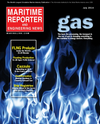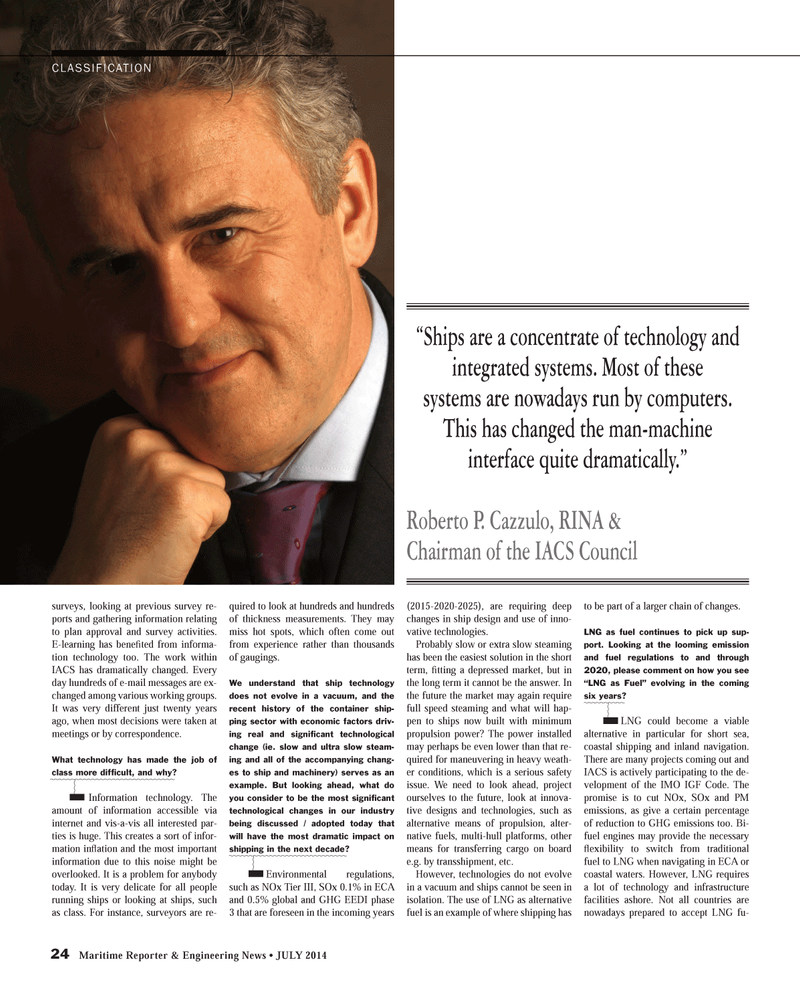
Page 24: of Maritime Reporter Magazine (July 2014)
Offshore Energy Structures & Systems
Read this page in Pdf, Flash or Html5 edition of July 2014 Maritime Reporter Magazine
24 Maritime Reporter & Engineering News • JULY 2014
CLASSIFICATION surveys, looking at previous survey re- ports and gathering information relating to plan approval and survey activities.
E-learning has benefi ted from informa- tion technology too. The work within
IACS has dramatically changed. Every day hundreds of e-mail messages are ex- changed among various working groups.
It was very different just twenty years ago, when most decisions were taken at meetings or by correspondence.
What technology has made the job of class more diffi cult, and why? Information technology. The amount of information accessible via internet and vis-a-vis all interested par- ties is huge. This creates a sort of infor- mation infl ation and the most important information due to this noise might be overlooked. It is a problem for anybody today. It is very delicate for all people running ships or looking at ships, such as class. For instance, surveyors are re- quired to look at hundreds and hundreds of thickness measurements. They may miss hot spots, which often come out from experience rather than thousands of gaugings.
We understand that ship technology does not evolve in a vacuum, and the recent history of the container ship- ping sector with economic factors driv- ing real and signifi cant technological change (ie. slow and ultra slow steam- ing and all of the accompanying chang- es to ship and machinery) serves as an example. But looking ahead, what do you consider to be the most signifi cant technological changes in our industry being discussed / adopted today that will have the most dramatic impact on shipping in the next decade? Environmental regulations, such as NOx Tier III, SOx 0.1% in ECA and 0.5% global and GHG EEDI phase 3 that are foreseen in the incoming years (2015-2020-2025), are requiring deep changes in ship design and use of inno- vative technologies.
Probably slow or extra slow steaming has been the easiest solution in the short term, fi tting a depressed market, but in the long term it cannot be the answer. In the future the market may again require full speed steaming and what will hap- pen to ships now built with minimum propulsion power? The power installed may perhaps be even lower than that re- quired for maneuvering in heavy weath- er conditions, which is a serious safety issue. We need to look ahead, project ourselves to the future, look at innova- tive designs and technologies, such as alternative means of propulsion, alter- native fuels, multi-hull platforms, other means for transferring cargo on board e.g. by transshipment, etc.
However, technologies do not evolve in a vacuum and ships cannot be seen in isolation. The use of LNG as alternative fuel is an example of where shipping has to be part of a larger chain of changes.
LNG as fuel continues to pick up sup- port. Looking at the looming emission and fuel regulations to and through 2020, please comment on how you see “LNG as Fuel” evolving in the coming six years? LNG could become a viable alternative in particular for short sea, coastal shipping and inland navigation.
There are many projects coming out and
IACS is actively participating to the de- velopment of the IMO IGF Code. The promise is to cut NOx, SOx and PM emissions, as give a certain percentage of reduction to GHG emissions too. Bi- fuel engines may provide the necessary fl exibility to switch from traditional fuel to LNG when navigating in ECA or coastal waters. However, LNG requires a lot of technology and infrastructure facilities ashore. Not all countries are nowadays prepared to accept LNG fu- “Ships are a concentrate of technology and integrated systems. Most of these systems are nowadays run by computers.
This has changed the man-machine interface quite dramatically.”
Roberto P. Cazzulo, RINA &
Chairman of the IACS Council
MR #7 (18-25).indd 24 6/30/2014 10:15:15 AM

 23
23

 25
25
